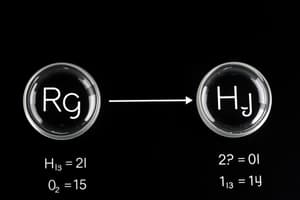Podcast
Questions and Answers
What is stoichiometry?
What is stoichiometry?
- Part of chemistry that studies amounts of substances involved in reactions (correct)
- Part of physics that studies energy changes
- Part of biology that studies chemical reactions
- Part of mathematics that studies amounts
Define mole ratio.
Define mole ratio.
Identify how many moles of product are formed from a certain amount of reactant.
What is molar mass?
What is molar mass?
The mass of a given substance divided by its amount of substance.
What is a limiting reactant?
What is a limiting reactant?
What is an excess reactant?
What is an excess reactant?
What is theoretical yield?
What is theoretical yield?
Define actual yield.
Define actual yield.
What is percent yield?
What is percent yield?
What is a reactant?
What is a reactant?
What is a product in chemical reactions?
What is a product in chemical reactions?
Explain the concept of mole ratio in reaction stoichiometry problems.
Explain the concept of mole ratio in reaction stoichiometry problems.
Differentiate between theoretical yield and actual yield in stoichiometric calculations.
Differentiate between theoretical yield and actual yield in stoichiometric calculations.
What is the role of molar mass in stoichiometry?
What is the role of molar mass in stoichiometry?
What is the percentage yield of a reaction?
What is the percentage yield of a reaction?
Why are actual yields usually less than calculated theoretical yields?
Why are actual yields usually less than calculated theoretical yields?
What is the first step in a stoichiometry problem?
What is the first step in a stoichiometry problem?
How can you determine the limiting reactant?
How can you determine the limiting reactant?
Study Notes
Stoichiometry Basics
- Stoichiometry studies the quantities of substances involved in chemical reactions.
- Mole ratio indicates how many moles of product can be produced from a specific amount of reactant.
Key Terms
- Molar mass is the mass of a substance divided by its amount (typically in moles).
- Limiting reactant determines the maximum amount of product that can be produced in a reaction.
- Excess reactant refers to the substances that remain after a reaction is complete.
Yields in Reactions
- Theoretical yield is the maximum quantity of product that could be generated from the limiting reactant.
- Actual yield is the amount of product actually obtained from the reaction.
- Percent yield is calculated as (actual yield / theoretical yield) × 100%.
Reaction Components
- Reactants are substances that undergo chemical changes during a reaction.
- Products are the new substances formed as a result of the reaction.
Stoichiometric Calculations
- Mole ratios serve as conversion factors for transitioning between moles of reactants and products, essential for balanced reactions.
- Theoretical yield is the expected outcome based on calculations, while actual yield reflects the practical result, often influenced by limiting reactants.
Problem-Solving Steps
- In stoichiometry problems, the first step is to write a balanced equation for the chemical reaction.
- To identify the limiting reactant, compare the number of moles of each reactant involved in the reaction.
Studying That Suits You
Use AI to generate personalized quizzes and flashcards to suit your learning preferences.
Description
Explore key concepts in Stoichiometry with these flashcards. Learn about essential terms such as mole ratio, molar mass, and limiting reactants. This quiz is designed to help solidify your understanding of how substances interact in chemical reactions.




